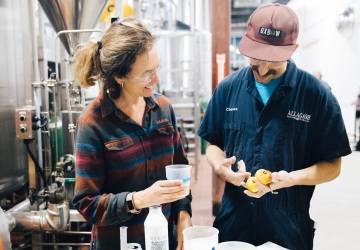Are you looking for the perfect guide to brew craft beer at home? Then, search no further because we will provide you with all the details and steps you need to know for brewing craft beer on your own.
Craft beer has gained immense popularity in recent years, captivating beer enthusiasts with its diverse flavors and unique styles.
This article will guide you through the process, from the basics to bottling, helping you create a flavourful and personalized brew that you can proudly share with friends and family.
1.Prepare yourself!
Understanding the Craft:
The world of craft beer is characterized by its complex blend of Flavors, styles, and ingredients. Firstly, you must understand that each brew emerges from a thoughtful curation of elements—the interplay of flavors—ranging from the bitterness of hops to the nuanced sweetness of malted grains.
While commercial brews have their fascination, the pursuit of crafting your own is an art of its own. It's the ultimate opportunity to paint your canvas of taste.
Gathering the necessary Tools and Ingredients:
Once you get the motivation to brew craft beer independently, gathering the required tools is the first and most important requirement. Each instrument has a role, from the indispensable brew kettle to the fermentation vessel.
Similarly, raw ingredients have the same importance as brewing tools, including malted grains, hops, yeast, and water. These elements sum up to give the intricate flavor to the craft beer that you are craving.

2.Let's Start the Brewing Process
Malting and Mashing:
The malting process encompasses a sequence of three stages. To commence, the barley, often called the dormant grain, undergoes steeping. This initial step serves as an awakening, rousing the grain from its slumber.
Following this, the grain is granted the liberty to germinate and bloom, marking a crucial transformation phase. Eventually, the process culminates in applying heat or kilning, contributing both the definitive color and the nuanced flavor that characterizes the barley's final form.
After malting, the journey leads to mashing. Here, crushed grains and water combine to create the "mash." This mixture works its magic, turning malt and starches into sugars while proteins and other elements dissolve, forming a sweet liquid known as the wort.
Boiling and Adding Hops:
After malting and mashing, the next crucial step in this brewing process will be adding hops. This is where bitterness, flavor, and aroma intertwine.
However, it's crucial to understand that introducing hops early in the boiling process generates bitterness, while adding hops midway infuses the brew with flavor. As the boil nears its conclusion, incorporating jumps at this stage imparts a delightful aroma to the final concoction.
The variety of hops you choose holds the key to the notes your beer will sing. The boiling state not only adds up flavors but also sets the stage for fermentation.
Cooling and the Fermentation state:
After the boiling phase, it's important to quickly cool the brew before introducing yeast. The choice of yeast will influence the beer's character.
The real magic happens in fermentation – sugars change into alcohol and carbonation forms. This process relies on precise temperature control.
These elements also contribute proteins, which, in collaboration with sugars and supplementary flavoring agents such as hops, give rise to the alcohol, flavors, and aromas that form the essence of the cherished drink we recognize as beer.
3.Crafting the Culmination
Refining Through Clarification and Conditioning:
Before the ultimate pour, clarity is a goal. Fining agents or cold treatment can be employed to achieve that polished appearance. The conditioning phase, often underestimated, bestows your beer with a polished and harmonious character.
Bottling and Carbonation:
Transitioning to the bottling phase, patience takes the reins—a calculated addition of priming sugar, and bottling seals the fate of your carbonation. As time passes, carbonation evolves – a reminder that good things come to those who wait.
4.Achieving Excellence with Expert Tips
Prioritizing Pristine Cleanliness:
A crucial aspect of successful brewing is impeccable sanitization. This means meticulously cleaning all equipment and surfaces. A sanitized environment guarantees your selected yeast holds the spotlight and is free from unwelcome invaders.

Embracing the Art of Creativity:
Think of your craft beer journey as a canvas for creativity – let your imagination run wild. Explore different possibilities by trying various grains, hops, yeast strains, and extra ingredients. This adventure in innovation can reveal unique and surprising results, making your brew stand out.
5.Bottling Your Creation
Thorough Cleaning is Key:
Ensure a pristine setup by cleansing every element involved – bottles, bottle fillers, bottle caps, bottling buckets, and transfer hoses. A bottle brush effectively scrubs the bottles, ensuring they're immaculate.
Careful Transfer:
Gently siphon your beer from the fermenter into the bottling bucket. Precision matters here–leave as much sediment in the fermenter as possible.
Filling the Bottles:
Attach the bottle filler to the hose and connect the hose to the bottling bucket spigot. Open the tap, allowing the beer to flow into the bottle filler at the bottom. This meticulous process ensures each bottle is a vessel of your crafted perfection.
6.Enjoying the Fruits of Your Labor
The Reward of Patience:
Homebrewing is a lesson in patience. Every phase, from fermentation to carbonation, is a tribute to the joy of anticipation. The wait is an essential ingredient in crafting the perfect brew.
Sharing the Joy:
Beer is inherently a social pleasure. Invite friends and family to savor your creation. Observing their enjoyment is the crowning achievement of your brewing journey, making every moment and effort worthwhile.
Conclusion:
Crafting your beer at home isn't just science; it's an art form that requires precision with creative expression. Be it a seasoned brewer or a newcomer, creating your craft beer is a venture that bridges the formal and the spirited, yielding a product that reflects your taste as it is a testament to your ingenuity. By following this whole guide, you will be able to brew your craft beer at home easily.